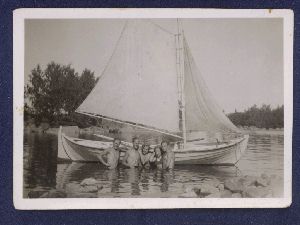
Cotton sails and a rig for our boat:
This was the former boat of Manta's first owner and it was built in the same village as Manta. We tried to follow the same style with our restoration. The sails are much smaller and the boat is about 80 cm (2' 8") shorter than ours. The boat had no motor, but it could be rowed with two pairs of oars.
We collected old photographs from relatives and the National Board of Antiquities to find clues for a proper sail plan. At first there were problems of finding a sailmaker who could design a traditional rig and sew the sails in cotton. We started thinking also other materials, yellowish "cream" dacron etc. and found a cotton-imitation called Duradon, which looks more like cotton but is made of short-fibre dacron. We almost ordered our sails sewed in duradon, but then we found Jouni Lahdenperä, a pilot from Aland Islands who has sewed dozens of cotton sails from little dinghies to three-mast schooners. He had also Duradon, but to our surprise cotton as material was considerably cheaper than Duradon. And why take an imitation when you can have the real thing, and even cheaper.
 Jouni did a great job on the sails.
The boltropes of tar-impregnated hemp rope and all the rings are hand-sewn.
The running rig is of hemp and partly we used a hemp-imitation, Hempex for easier
handling. Sailcloth is 12 oz cotton.
Jouni did a great job on the sails.
The boltropes of tar-impregnated hemp rope and all the rings are hand-sewn.
The running rig is of hemp and partly we used a hemp-imitation, Hempex for easier
handling. Sailcloth is 12 oz cotton.
The mast has no stays so it's easy to take down. Mast, boom and sprit are made from spruce, Picea Abies. Lumber for the rig was cut down in January and it was partially barked to allow very slow drying.
The picture above shows how the rig looked like at the first summer. There still was some problems, biggest of them all was too flexible spars. In a strong breeze the mast was bent like a fishing rod. The jib was a bit small to make a real difference and the mast was placed too far ahead to allow comfortable rowing.
 At the winter
1998-1999 we decided to rebuild the whole rig. We moved the mast back 30 cm
(1') to allow a better rowing position and to make the jib bigger.The spritsail
was reduced by cutting a panel off the leech. A reef was also sewed to the sail.
At the winter
1998-1999 we decided to rebuild the whole rig. We moved the mast back 30 cm
(1') to allow a better rowing position and to make the jib bigger.The spritsail
was reduced by cutting a panel off the leech. A reef was also sewed to the sail.
We also fell a few bigger spruces for new spars. The new ones are stiff enough for a rig like this yet light to allow easy handling.
 We now had two jibs in the boat,
since it was easier to sew a completely new jib instead of enlarging the old
one. We decided to try to fit them both to the boat, just because I have always
been keen on a cutter rig.
We now had two jibs in the boat,
since it was easier to sew a completely new jib instead of enlarging the old
one. We decided to try to fit them both to the boat, just because I have always
been keen on a cutter rig.
Sailing with two jibs is a little awkward on a small boat like ours. For that reason -and because I wanted to keep the boat traditional - the bowspirit had to be removable. It is attached to the boat only with a single pin and there is a support, which keeps it straight. I didn't have to do any alterations to the boat.
 Cotton has its disadvantages. It
absorbs quite much water and becomes pretty heavy when wet. It also gets mildew
quite easily if it is packed when it's wet. Mildew weakens the canvas unlike
on dacron sails, and cleaning of mildewed areas is hard: chlorine or oxalic
acid helps sometimes, but it takes also the natural color of the sail. So, you
can't just leave the sails to a big bundle under the cabin seat.
Cotton has its disadvantages. It
absorbs quite much water and becomes pretty heavy when wet. It also gets mildew
quite easily if it is packed when it's wet. Mildew weakens the canvas unlike
on dacron sails, and cleaning of mildewed areas is hard: chlorine or oxalic
acid helps sometimes, but it takes also the natural color of the sail. So, you
can't just leave the sails to a big bundle under the cabin seat.
Next: Rigging